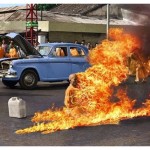
The Geneva Accords were finalised in late July 1954. In theory, North and South Vietnam were to exist for two years as temporary transitional states. In reality, both had already begun to develop and consolidate into separate national entities. As this process unfolded the divisions between North and South Vietnam widened, reducing the likelihood of free national elections or successful reunification. The new rulers of South Vietnam were backed by the United States and their Western allies. These men, epitomised by the Christian prime minister Ngo Dinh Diem, presented themselves as aspiring democrats and capitalists. After fighting to remove the shackles of French colonialism, they claimed to desire a free and independent South Vietnam based on Western political and economic values. What unfolded under their leadership, however, was neither democratic or beneficial to most South Vietnamese people.
Ngo Dinh Diem became the prime minister of South Vietnam in 1954, thanks largely to American manipulation. From the outset, Ngo faced considerable challenges from criminals and political opponents, particularly communist subversives still active in the southern provinces. Thousands of Viet Minh agents and guerrilla soldiers, most acting on orders from Hanoi, ignored the migration amnesty of 1954-55 and remained underground in South Vietnam. Ho Chi Minh, who doubted the 1956 elections would take place, described these agents as his “insurance”. Opposition to Ngo Dinh Diem could also be found in the military. In November 1954 a clique of officers, trained by and loyal to the French, attempted to remove Diem and install a Francophile military junta. Their coup was thwarted by Diem, with the help of the US Central Intelligence Agency (CIA). The continuation of the opium trade, another legacy of French colonialism, also encouraged warlords, organised crime and gangsterism.
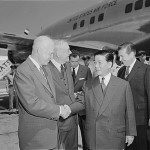
The newly appointed Diem was determined to deal with all of these problems. When he assumed power, however, South Vietnam was bankrupt and without the organs of government. During their withdrawal from Indochina, the French had dismantled the apparatus of colonial government. In some cases entire buildings and departments had been cleared, their contents packed and shipped back to France, all in the space of a few months. The French also stripped South Vietnam of important resources, from military equipment down to telephones and typewriters. By late 1955 there was almost no army, no police force and very little functioning bureaucracy. Not only did Diem have to persuade the South Vietnamese that he was in charge, he also had to construct a working system of government.
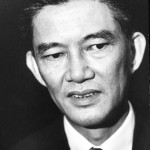
Without an established bureaucracy or political network, Diem relied on American advisors – and on his own family. His most prominent relatives were his four brothers – Ngo Dinh Nhu, Ngo Dinh Thuc, Ngo Dinh Can and Ngo Dinh Luyen – and one of his sisters-in-law, Tran Le Xuan (later known in the West as Madame Nhu). Diem gave his family members, friends and political allies important leadership positions in the government, military, business and Vietnam’s Catholic church. His closest confidante was his brother, Ngo Dinh Nhu, an opium-addicted neo-Nazi who lived alongside Diem in the presidential mansion. Nhu oversaw the creation and organisation of the Army of the Republic of Vietnam (ARVN, formed in October 1955) while also running his own private armies and anti-communist ‘death squads’. In late 1954 Nhu attempted to provide political legitimacy for his brother’s regime by forming the Can Lao, a South Vietnamese party that Nhu hoped would grow to rival Ho Chi Minh’s Lao Dong. Can Lao never inspired the people or became a popular movement, however, and remained relatively small. Membership was only open to pro-Diem Catholics from the middle and upper classes. In reality, Can Lao was just a political device to justify Diem’s rule.
By 1956 Diem’s regime had taken clearer form. Though the South Vietnamese government presented itself to the world as a developing democracy, it was anti-democratic, autocratic, corrupt and nepotistic. There was a National Assembly that claimed to be representative, though rigged elections meant it was nothing of the kind. The Assembly was filled with Diem’s acolytes and did little more than rubber stamp Diem’s own policies. Freedom of the press was curtailed; writing or protesting against the government could end in a prison sentence, or worse. The regime was also strong enough to back Diem’s anti-communist rhetoric with firm action. Under Nhu’s supervision, private armies launched campaigns to locate, arrest and dispose of suspected communists and sympathisers in South Vietnam. Thousands were rounded up, deported, tortured, thrown in prison or executed. According to some sources, more South Vietnamese were killed during Diem’s four year anti-communist purge than during the First Indochina War of 1946-54. In May 1959 Diem issued the notorious Law 10/59. This decree empowered military tribunals to impose a death sentence on anyone belonging to the Viet Minh, Lao Dong or any other communist organisation:
“Article 1
The sentence of death, and confiscation of the whole or part of his property will be imposed on whoever commits or attempts to commit one of the following crimes with the aim of sabotage, or upon infringing upon the security of the State, or injuring the lives or property of the people:
i. Deliberate murder, food poisoning, or kidnapping.
ii. Destruction, or total or partial damaging, of … objects by means of explosives, fire, or other means
Article 3
Whoever belongs to an organisation designed to help to prepare or to perpetuate crimes enumerated in Article 1, or takes pledges to do so, will be subject to the same sentences.”
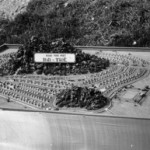
The Diem regime also embarked on a program of social reorganisation, which it hoped would disrupt communist influence. In 1959 the Saigon government introduced the Rural Community Development Program, or ‘Agrovilles’ (khu tru mat). It was effectively a program of mass resettlement: peasants in small villages or isolated areas were forced to relocate to populated areas under government control. It had some similarities to Soviet farm collectivisation, though its objectives were more political than economic. By the early 1960s, there were more than two dozen Agrovilles in South Vietnam. Each contained several thousand peasants, most driven there at the point of a gun, from villages which had previously contained just a few families. The Agroville resettlements caused enormous social and economic disruption. Families were separated, shifted from familiar territory and forced to abandon important spiritual sites, such as temples and ancestral graves. Most of these Agrovilles were too small for everyone to be given plots of land or employed as farmers, meaning there was little or no work.
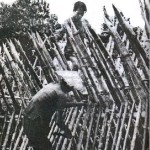
In 1961 the ‘Agroville’ scheme was transformed into ‘strategic hamlets’ (ap chien luoc). This initiative was suggested to Diem by American advisors and developed largely by the CIA. The strategic hamlets were intended to be a network of self-sustaining communities, strong enough to withstand communist infiltration and attack. Peasants would be moved into these large rural settlements; they would be compensated for this relocation and allocated plots of land. Each strategic hamlet would be provided with a defendable perimeter, small arms and militia training; it would be outfitted with a radio or telephone connection to make contact with the government, ARVN and nearby hamlets. But like the Agrovilles, the strategic hamlets program failed, mainly because it was poorly implemented. Despite a barrage of CIA-produced propaganda, most peasants did not wish to relocate. Much of the money set aside for compensation ended up in the pockets of corrupt government officials – including Diem’s own family – rather than being distributed to the peasants. By late 1963 the South Vietnamese government claimed to have completed 8,600 strategic hamlets, however, a subsequent American investigation found that four-fifths of these were incomplete. American funding dried up and the program soon faded away. Many strategic hamlets were abandoned, stripped of whatever was useful and left to rot.
Despite its failures and rampant corruption, the Diem government did make some progress in industrialising the economy. South Vietnam’s status as a developing nation recovering from war and colonialism received extensive media coverage in the West. This prompted many Western companies to assist Saigon with trade and investment. In 1957 Diem announced a five-year economic plan and called for foreign loans and domestic investment. Those who invested in the South Vietnamese economy, particularly its export industries, were promised government guarantees and concessions, such as lower tax rates and land rents. Local companies were subsidised and locally produced goods were protected with tariffs. Meanwhile, the government and its agencies imported much-needed equipment: factory and farm machinery, motor vehicles and raw materials such as steel and ore. South Vietnam’s agricultural sector also recovered. Rice production boomed, growing from 70,000 tons per annum (1955) to 340,000 tons (1960). Predictably, Diem’s main trading partner during this period was the United States. Between 1954 and 1960 the US government pumped around $US1.2 billion into South Vietnam, about three-quarters of which was used to expand and bolster the military. Washington also offered incentives to American companies willing to trade with South Vietnam.
“[US ambassador to South Vietnam] Henry Cabot Lodge arrived in Saigon on August 22nd 1963 [and] delivered his own speech [to Diem]. “I want you to be successful. I want to be useful to you. I don’t expect you to be a ‘yes man’. I realise that you must never appear a puppet of the United States.” Nonetheless, he insisted that Diem had to face the fact American public opinion had turned against him. The United States, Lodge asserted, ‘favours religious toleration’, and Diem’s policies were ‘threatening American support of Vietnam’. Diem had to set his house in order, and that meant removing his brother Ngo Dinh Nhu, silencing Madame Nhu, punishing those responsible for the May massacre in Hue, and conciliating the Buddhists. Washington was no longer prepared to support the Diem regime unconditionally.”
Seth Jacobs, historian
The relative success of Diem’s economic program enabled many to overlook the brutality and excesses of his regime. It was Diem’s persecution of another group – South Vietnam’s Buddhists – which made headlines around the world and spelt the beginning of the end for his regime. More than three-quarters of the South Vietnamese population was Buddhist, however, it was minority Catholics who benefited most under Diem’s regime. Government officials, high ranking military officers, business owners and landlords in receipt of government assistance were overwhelmingly Catholic. Many even converted to Catholicism just to win favour with the regime. In May 1963, on the eve of Vesak – a celebration of Buddha’s birthday – Diem issued a decree banning the display of religious flags in public. Thousands of Buddhists in Hue rioted in response; the demonstration was brutally dispersed by government forces and eight people were killed. Vietnamese Buddhists protested their treatment with a series of rallies, sit-ins and hunger strikes. In June, Diem’s forces dealt with one protest by using tear gas and pouring battery acid on the heads of seated Buddhists. In July, a group of American journalists covering Buddhist protests were involved in a fistfight with a group of Diem’s secret police.
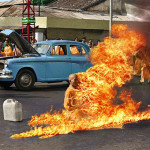
The most striking incident occurred in Saigon on June 11th. In the middle of a busy street, a Buddhist monk named Thich Quang Duc calmly sat down and delivered a short speech, then had a colleague douse him in gasoline. Duc then set himself alight and sat motionless as the flames engulfed his body. Images and footage of Duc’s suicide were circulated worldwide. His self-immolation drew attention to the Buddhist plight in South Vietnam and the corruption and inherent brutality of Diem’s regime. Even this did not halt Diem’s anti-Buddhist program. In August, shortly before a major Buddhist protest rally in Saigon, Diem declared martial law in the city. He authorised ARVN forces to raid Saigon’s Buddhist pagodas and arrest suspected “communist sympathisers”. Hundreds of Buddhists were arrested and many vanished, probably murdered. Thousands more fled and their pagodas were desecrated by Diem’s troops. In Washington, the situation in South Vietnam was now considered untenable. Diem seemed almost uncontrollable and his regime was a constant source of bad news and negative publicity. In late August, just days after the anti-Buddhist raids, president John F. Kennedy asked the State Department to investigate the options for ‘regime change’ in South Vietnam.

1. Between 1954 and 1963 South Vietnam was a nominally democratic republic, propped up by American political and financial support. In reality, there was little democratic about its government.
2. South Vietnam’s leader, Ngo Dinh Diem, claimed to head a democratic government. In reality, Diem was a petty dictator, assisted by family members, Catholic acolytes and US advisors.
3. During his rule, Ngo Dinh Diem authorised brutal campaigns against his political enemies, particularly suspected communists (1955-59) and Vietnam’s Buddhist monks (1963).
4. Diem’s social program included the failed ‘Agroville’ and ‘strategic hamlet’ resettlement programs. His economic reforms, helped by foreign trade, were more successful.
5. The United States supported Diem and his government with advisors and money, however by August 1963 Diem was a liability and Washington began investigating ways to remove him.
© Alpha History 2018. Content on this page may not be republished or distributed without permission. For more information please refer to our Terms of Use.
This page was written by Jennifer Llewellyn, Jim Southey and Steve Thompson. To reference this page, use the following citation:
J. Llewellyn et al, “South Vietnam”, Alpha History, accessed [today’s date], https://alphahistory.com/vietnamwar/south-vietnam/.
